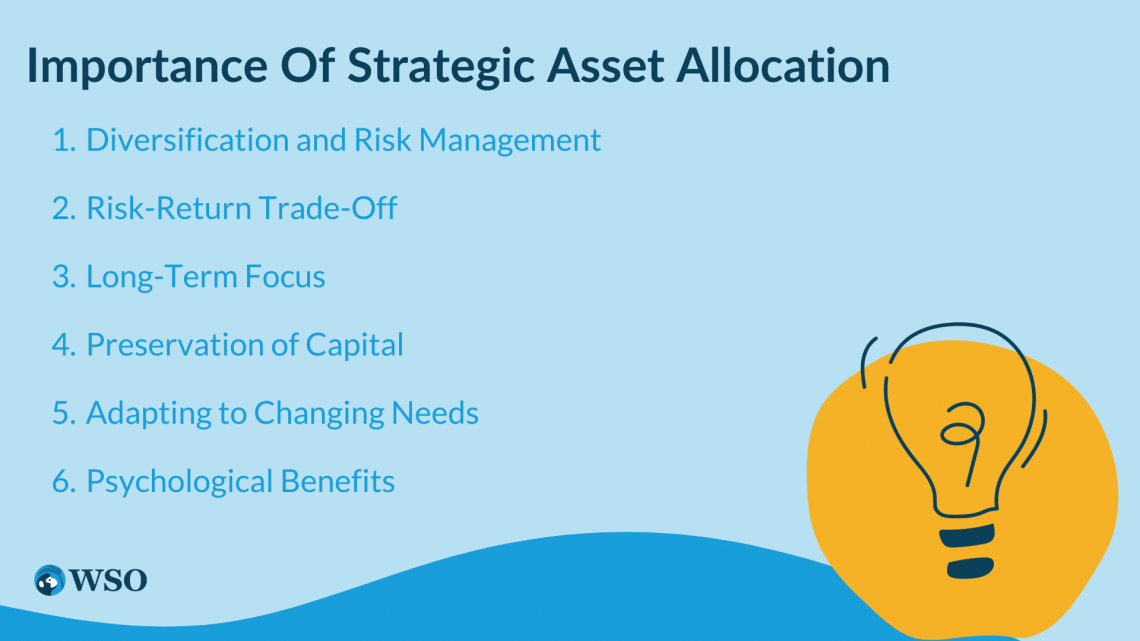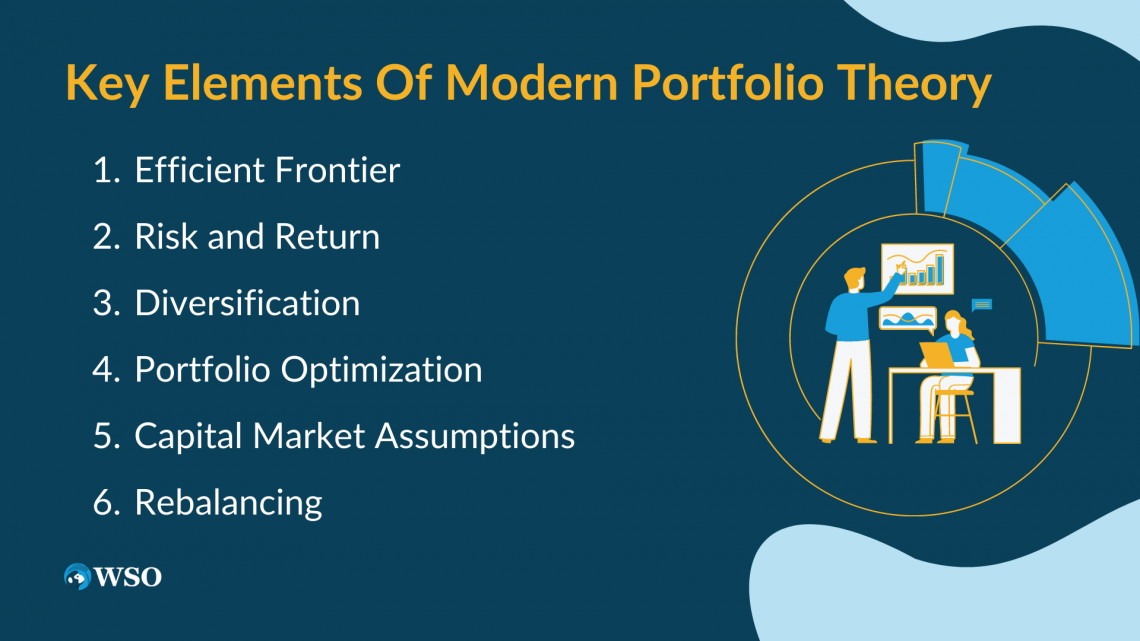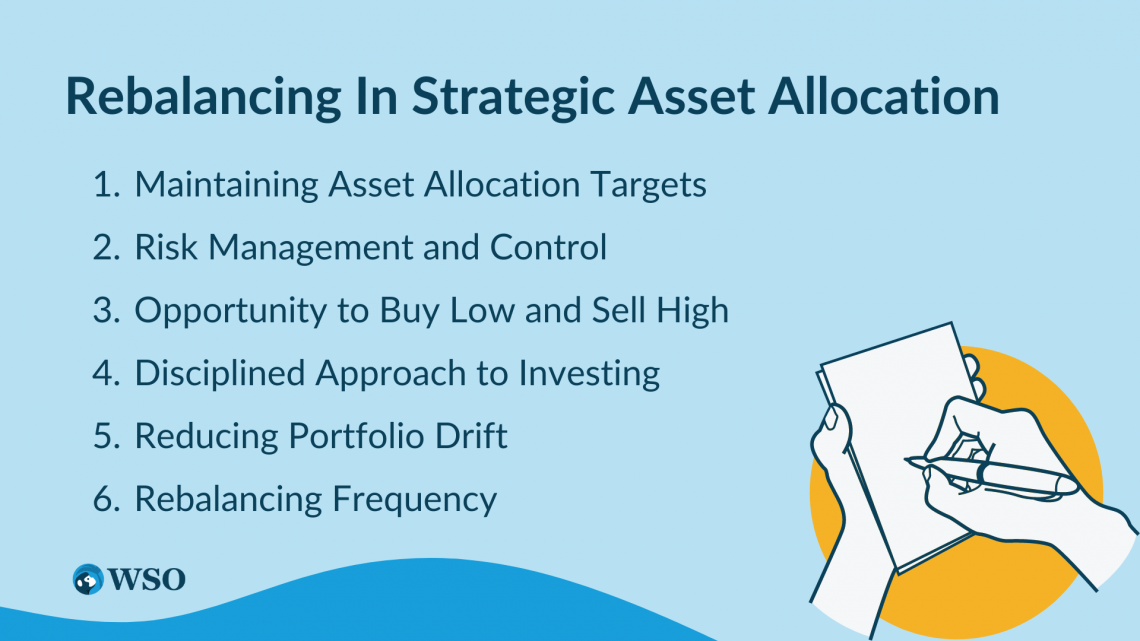Strategic Asset Allocation (SAA)
Strategic Asset Allocation(SAA) is a long-term portfolio strategy which entails selecting asset class allocations and routinely adjusting the allocations.
What Is Strategic Asset Allocation (SAA)?
Strategic asset allocation (SAA) is a disciplined approach to constructing an investment portfolio that involves selecting and allocating assets based on their risk-return characteristics and the investor's objectives. It is crucial in investment management, allowing investors to reach long-term financial objectives.

Fundamentally, strategic asset allocation acknowledges that various asset classes exhibit varying long-term performance, including stocks, bonds, cash, real estate, and alternative assets.
SAA's main goal is to build a well-balanced portfolio that matches an investor's risk tolerance, time horizon, and financial goals. Rather than attempting to time the market or chase short-term trends, strategic asset allocation focuses on long-term investment strategies.
One of the fundamental principles behind SAA is diversification. Diversifying a portfolio involves spreading investments across different asset classes with low or negative correlations.
By doing so, the overall portfolio becomes less susceptible to the performance of any single asset class. Diversification can help mitigate the impact of market volatility and reduce the risk associated with concentrated investments.

For instance, bonds or other asset types may offer stability and safeguard against losses when stocks are underperforming. Conversely, when stocks are performing well, other asset classes may lag. However, the diversified portfolio is designed to capture the overall growth potential.
Another key consideration in strategic asset allocation is the risk-return trade-off. Different asset classes carry varying levels of risk and potential returns. Assets with greater potential profits simultaneously carry greater risk.
For instance, stocks historically offer higher returns than bonds but are more volatile and subject to short-term price swings. On the other hand, bonds generally offer lower returns but are more stable and provide income through interest payments.

Strategic asset allocation involves balancing risk and return based on an investor's risk appetite and financial goals. By diversifying across asset classes with different risk-return profiles, investors can pursue their objectives while managing risk effectively.
Implementing a strategic asset allocation strategy involves several steps. First, investors must assess their risk tolerance, investment horizon, and financial goals. This assessment helps determine the appropriate asset allocation mix that aligns with their unique circumstances.
Once the asset allocation targets are established, investors select investments that fit within each asset class. Selecting particular stocks, bonds, mutual funds, exchange-traded funds (ETFs), or other investment vehicles may be required.
The selection process typically considers factors such as historical performance, fees, and the underlying investment philosophy.
Key Takeaways
- Strategic asset allocation (SAA) is a disciplined approach to constructing an investment portfolio based on risk-return characteristics and the investor's objectives.
- One of the fundamental principles behind strategic asset allocation is diversification.
- Strategic asset allocation is a long-term plan.
- Implementing a strategic asset allocation strategy involves assessing risk tolerance, investment horizon, and financial goals.
Importance Of Strategic Asset Allocation
It is impossible to exaggerate how important asset allocation is in investment management. It serves as the foundation for achieving long-term financial goals while managing risk effectively.

The following are some major justifications for asset allocation being crucial to an investment strategy:
1. Diversification and Risk Management
Diversification helps reduce the risk associated with any single investment. When one asset class underperforms, others may compensate, mitigating the impact on the overall portfolio.
By spreading investments across various asset classes, investors can potentially reduce volatility and protect their portfolios from severe market downturns.
2. Risk-Return Trade-Off
SAA allows investors to balance their desired level of risk with their expected return. Different asset classes have varying risk-return characteristics.
Example
Stocks generally offer higher potential returns but come with greater volatility, while bonds provide more stability but lower potential returns.
3. Long-Term Focus
SAA emphasizes a long-term investment approach rather than short-term market timing. It aids in avoiding automatic responses to transient market swings, frequently leading to poor investment choices.
It encourages investors to stay focused on their financial goals and maintain a disciplined investment strategy even during market volatility.
4. Preservation of Capital
These strategies can help preserve capital during challenging market conditions. By diversifying investments across asset classes with low or negative correlations, losses in one asset class can be offset by gains in others.
This helps protect the overall portfolio value and provides a buffer against significant downturns.
Note
Strategic asset allocation can help mitigate the risk of permanent capital impairment, ensuring investors are more likely to preserve their invested capital over the long run.
5. Adapting to Changing Needs
As investors progress through different life stages or experience changes in their financial circumstances, their investment needs may evolve. Strategic asset allocation allows for flexibility and adaptation to changing needs.
For example, a young investor with a longer time horizon and higher risk tolerance may have a more aggressive asset allocation, while someone approaching retirement may shift towards a more conservative allocation to protect their accumulated wealth.
Note
Regular reviews of the strategic asset allocation ensure the portfolio remains aligned with the investor's changing objectives and risk tolerance.
6. Psychological Benefits
SAA provides psychological benefits by reducing the emotional stress associated with investing. Market volatility and unpredictable swings can lead to impulsive decision-making, often resulting in poor investment choices.
It provides a disciplined framework that promotes rational decision-making, reducing the potential for emotional biases and enhancing overall investment success.
Determining Risk Tolerance For Strategic Asset Allocation
One of the key factors in SAA is understanding and determining an investor's risk tolerance. The ability and willingness of a person to withstand changes in the value of their investments is referred to as risk tolerance.

By assessing risk tolerance accurately, investors can align their asset allocation decisions with their comfort level, financial goals, and investment time horizon. Here are a few typical techniques for figuring out your risk tolerance:
1. Risk Assessment Questionnaires
These questionnaires often include a series of inquiries that test a potential investor's preferences, financial condition, investing objectives, and responses to various fictitious situations.
The responses help evaluate the individual's risk tolerance and provide a framework for constructing an appropriate asset allocation strategy.
2. Investment Experience and Knowledge
An investor's experience and knowledge of financial markets can also influence risk tolerance. Seasoned investors who have weathered market cycles and have a deep understanding of investment principles may be more comfortable taking on higher levels of risk.
Note
Novice investors or those with limited experience may prefer a more conservative approach to mitigate potential losses.
3. Financial Goals and Time Horizon
An investor's financial goals and investment time horizon are critical considerations in determining risk tolerance.
Those with longer time horizons, such as young individuals investing for retirement, generally have more flexibility to withstand short-term market volatility and may have higher risk tolerance.
4. Psychological Factors
Risk tolerance is not solely based on financial factors but is also influenced by psychological factors. Some individuals naturally possess a higher tolerance for risk and are more comfortable with market fluctuations, while others may have a lower tolerance and prefer stability and capital preservation.
Understanding one's emotional response to risk and market volatility is crucial in determining an appropriate asset allocation strategy.
Note
Life events, market conditions, and evolving financial goals can influence an individual's risk tolerance. Regular reassessment of risk tolerance and adjusting asset allocation is essential to maintain a suitable investment strategy.
Modern Portfolio Theory (MPT)
Modern Portfolio Theory (MPT) is a framework developed by economist Harry Markowitz that revolutionized the concept of strategic asset allocation. MPT provides a systematic approach to constructing portfolios by considering the risk-return trade-off and diversification benefits.

MPT has greatly influenced modern investment practices, providing a quantitative and systematic approach to portfolio construction.
Despite its limitations and various assumptions, MPT is a useful tool for investors aiming to improve their portfolios by considering the benefits of diversity and the risk-return trade-off.
By applying MPT principles, investors can construct well-diversified portfolios that align with their risk tolerance and financial goals. Here are key elements of MPT:

1. Efficient Frontier
MPT introduces the concept of the efficient frontier, which represents a set of optimal portfolios that offer the maximum expected return for a given level of risk or the minimum risk for a given level of expected return.
Portfolios below the efficient frontier are considered inefficient because they fail to maximize returns or minimize risk.
2. Risk and Return
MPT recognizes that investments carry both risk and return. Risk is measured by the standard deviation, representing the volatility or fluctuations in an investment's returns. Return refers to the gain or loss of an investment.
Note
MPT seeks to achieve the highest return possible for a given level of risk or the lowest risk for a desired level of return.
3. Diversification
MPT emphasizes the importance of diversification to reduce risk. By spreading investments across multiple asset classes with low or negative correlations, investors can reduce the impact of individual asset fluctuations on the overall portfolio.
MPT suggests that adding assets to a portfolio can reduce risk without sacrificing potential returns up to a certain point.
4. Portfolio Optimization
MPT utilizes mathematical models to optimize portfolio allocations. By inputting historical return data and risk metrics of different assets, MPT algorithms can determine the optimal asset allocation mix that maximizes return or minimizes risk.
Note
The objective is to identify the portfolio that provides either the lowest risk for a target return or the highest return for a given level of risk.
5. Capital Market Assumptions
MPT relies on capital market assumptions to estimate future returns and risk for various asset classes. Economic statistics, historical data, and financial models support these presumptions.
It's crucial to remember that these assumptions could be wrong and that they might not be able to anticipate how the market will behave.
6. Rebalancing
MPT emphasizes the need for periodic portfolio rebalancing to maintain the desired asset allocation. Asset classes perform differently over time, so the portfolio's allocation may drift away from the original target.
Rebalancing involves selling or buying assets to restore the desired allocation, which helps to maintain the portfolio's risk profile and maximize its efficiency.
Strategic Vs. Tactical Asset Allocation
Asset allocation strategies can broadly be categorized into two main approaches: strategic and tactical. While both strategies aim to optimize portfolio performance, their time horizons and decision-making processes differ.

Let's explore the characteristics and considerations of each approach.
| Strategic Asset Allocation | Tactical Asset Allocation |
|---|---|
| Long-term approach | Short to medium-term approach |
| Based on target allocations for different asset classes | Based on market conditions and short-term opportunities |
| Focuses on maintaining the desired asset allocation mix over time | Adjusts asset allocation based on market outlook and forecasts |
| Emphasizes diversification and long-term market trends | Takes advantage of short-term market inefficiencies or mispricings |
| Reduces the impact of market volatility through a disciplined approach | Seeks to generate alpha by actively adjusting the portfolio |
| Less frequent adjustments to the portfolio | More frequent portfolio adjustments and reallocation |
| Requires periodic rebalancing to maintain target allocations | TAA can involve more trading and transaction costs |
| Suited for investors with a longer investment horizon and a passive investment approach | Suited for investors who are more active and have a shorter time horizon |
| Provides stability and consistency in the portfolio over time | Offers the potential for higher returns, but with increased risk and complexity |
Rebalancing In Strategic Asset Allocation
Rebalancing is a crucial aspect of SAA. It involves periodically adjusting the portfolio's asset allocation back to its original target or desired allocation.

The following are important factors and advantages of rebalancing:
1. Maintaining Asset Allocation Targets
SAA sets specific target allocations for different asset classes based on an investor's risk tolerance, time horizon, and investment goals. Over time, due to divergent performance among asset classes, the portfolio's asset allocation may deviate from these targets.
Rebalancing allows investors to return the asset allocation to their desired targets, reducing the risk of an imbalanced portfolio.
2. Risk Management and Control
Rebalancing is an essential risk management tool. It helps investors control and manage risk by selling assets that have appreciated significantly and reallocating the proceeds to underperforming assets.
Note
Investors can keep their portfolios balanced and limit their exposure to particular asset classes that may have become overvalued by purchasing cheap and selling high.
3. Opportunity to Buy Low and Sell High
Rebalancing allows one to exploit market fluctuations and capitalize on undervalued assets. Selling assets that have performed well and reallocating the proceeds to underperforming assets can generate higher returns in the long run.
This approach follows the investment adage of "buy low, sell high" and helps investors capture the benefits of mean reversion in asset prices.
4. Disciplined Approach to Investing
Rebalancing enforces discipline in an investor's approach to investing. It prevents emotional decision-making driven by short-term market movements.
Note
By adhering to a predetermined rebalancing schedule, investors remain focused on their long-term investment objectives and avoid making impulsive investment decisions based on market noise or temporary market trends.
5. Reducing Portfolio Drift
Without rebalancing, portfolios can experience "drift" over time, where the asset allocation gradually shifts away from the original targets. This drift can result in unintended exposure to certain asset classes, potentially increasing risk or reducing portfolio returns.
Rebalancing helps return the portfolio to its intended asset allocation, ensuring that the investment strategy remains consistent and aligned with the investor's goals.
6. Rebalancing Frequency
Others rebalance when the portfolio's allocation deviates from the objective by a specific percentage (for example, 5% or 10%), while some investors rebalance on a predetermined timetable, such as annually or semi-annually.
Note
It's important to strike a balance between maintaining the desired allocation and avoiding excessive trading costs.
Rebalancing is a critical component of effective asset allocation. It helps maintain the desired asset allocation targets, manage risk, capture investment opportunities, and ensure a disciplined approach to investing.
By periodically rebalancing the portfolio, investors can stay on track with their long-term investment objectives and maintain the intended risk-return profile of their investment strategy.










or Want to Sign up with your social account?